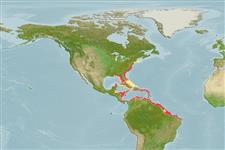Common names from other countries
>
Beloniformes (Needle fishes) >
Belonidae (Needlefishes)
Etymology: Strongylura: Greek, strongylos = round + Greek, oura = tail (Ref. 45335).
More on author: Walbaum.
Environment: milieu / climate zone / depth range / distribution range
Ecologia
marino; acqua dolce; salmastro associati a barriera corallina; distribuzione batimetrica 0 - ? m. Subtropical; 45°N - 9°S, 88°W - 34°W
Western Atlantic: Maine, USA and northern Gulf of Mexico to Brazil. Absent from the Bahamas and Antilles (Ref. 3129).
Size / Peso / Age
Maturity: Lm ? range ? - ? cm
Max length : 111 cm TL maschio/sesso non determinato; (Ref. 40637); common length : 60.0 cm TL maschio/sesso non determinato; (Ref. 5217); peso massimo pubblicato: 2.3 kg (Ref. 40637)
Raggi dorsali molli (totale) : 14 - 17; Raggi anali molli: 16 - 20. Black pigment behind eye, not extending below level of middle of eye (Ref. 26938).
Inhabits coastal areas and mangrove-lined lagoons. Enters freshwater. Feeds mainly on small fishes. Oviparous (Ref. 205). Eggs may be found attached to objects in the water by tendrils on the egg's surface (Ref. 205). Only the right gonad is developed (Ref. 26938). Marketed fresh.
Life cycle and mating behavior
Maturities | Riproduzione | Spawnings | Egg(s) | Fecundities | Larve
Robins, C.R. and G.C. Ray, 1986. A field guide to Atlantic coast fishes of North America. Houghton Mifflin Company, Boston, U.S.A. 354 p. (Ref. 7251)
IUCN Red List Status (Ref. 130435)
CITES (Ref. 128078)
Not Evaluated
Threat to humans
Harmless
Human uses
Pesca: scarso interesse commerciale; Pesce da pesca sportiva: si
Strumenti
Special reports
Download XML
Fonti Internet
Estimates based on models
Preferred temperature (Ref.
115969): 13.3 - 28, mean 26.1 (based on 304 cells).
Phylogenetic diversity index (Ref.
82804): PD
50 = 0.5001 [Uniqueness, from 0.5 = low to 2.0 = high].
Bayesian length-weight: a=0.00129 (0.00079 - 0.00211), b=3.05 (2.92 - 3.18), in cm Total Length, based on LWR estimates for this species & Genus-body shape (Ref.
93245).
Trophic level (Ref.
69278): 3.0 ±0.0 se; based on diet studies.
Resilienza (Ref.
120179): Medio, tempo minimo di raddoppiamento della popolazione 1.4 - 4.4 anni (Preliminary K or Fecundity.).
Fishing Vulnerability (Ref.
59153): High to very high vulnerability (67 of 100).
